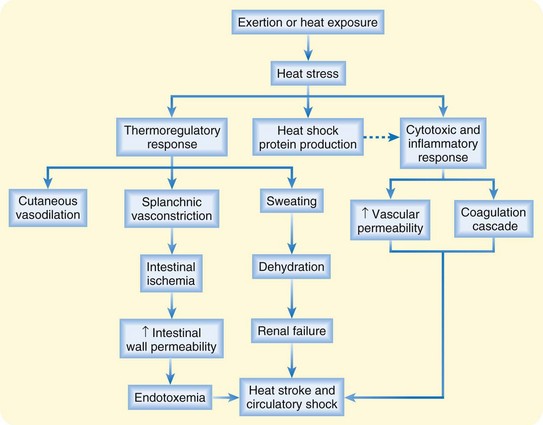130 Heat-Related Emergencies
• Heat stroke is a life-threatening hyperthermic syndrome characterized by central nervous system dysfunction and associated multisystem organ failure.
• The main goal of therapy is rapid reduction of the patient’s core temperature to about 39° C with one of two methods—evaporative cooling or cold water immersion.
Perspective
Heat-related injury spans a wide spectrum from the unpleasant and transient conditions of heat cramps or prickly heat to the life-threatening multisystem organ failure of heat stroke. The most important risk factors for heat illness are listed in Box 130.1. Mechanisms of acclimatization are listed in Table 130.1.
Box 130.1 Risk Factors for Severe Heat Illness
Table 130.1 Acclimatization Mechanisms
| Cardiac | Increased cardiac performance: higher cardiac output |
| Vascular | |
| Endocrine | An enhanced renin-angiotensin-aldosterone system and improved salt retention by the kidneys and sweat glands result in better fluid retention |
| Renal | Increased glomerular filtration rate |
| Sweat glands | The increased volume of sweat produced and the more dilute sweat reduce salt loss and indirectly diminish dehydration |
| Muscle | Improved ability to resist rhabdomyolysis from exertion |
| Cellular | Upregulated transcription of heat shock proteins |
Epidemiology
Roughly 688 people die yearly of heat-related causes, Arizona has the highest incidence at 1.7 per 100,000, followed by Nevada (0.8 per 100,000) and Missouri (0.6 per 100,000).1 An estimated half of the deaths are weather related, and 5% result from being enclosed in motor vehicles, boiler rooms, or kitchens; in the remaining cases, the causes are unspecified.2 Mortality from heat stroke with appropriate treatment is reported to be between 0% and 28%.3–5
Pathophysiology of Heat Stroke
Heat itself has a direct cytotoxic effect and causes cell death over a period of 45 minutes to 8 hours at body temperatures of 41.6° C to 42° C6; below these temperatures, cell death can still occur through apoptosis.7
Figure 130.1 diagrams the current understanding of the pathophysiology of heat stroke.
Minor Heat-Related Syndromes
Presenting Signs and Symptoms
As stated earlier, heat-related illness is a continuum. Table 130.2 summarizes the various types of heat illness.
Table 130.2 Heat-Related Illnesses and Treatment
| DIAGNOSIS | KEY FEATURES | TREatMENT |
|---|---|---|
| Mild | ||
| Heat edema | Mild edema of the hands and feet as a result of interstitial edema | |
| Prickly heat | Erythematous, maculopapular rash | |
| Heat cramps | Severe muscle spasms during or after vigorous exercise | |
| Severe | ||
| Heat exhaustion | ||
| Heat stroke | ||
Treatment
Most minor heat-related syndromes are mild and require simple or no treatment. Treatment is summarized in Table 130.2 for these conditions.








